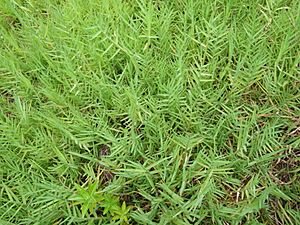Pseudoraphis spinescens facts for kids
Quick facts for kids Pseudoraphis spinescens |
|
|---|---|
 |
|
| Pseudoraphis spinescens | |
| Scientific classification | |
| Genus: |
Pseudoraphis
|
| Species: |
spinescens
|
| Synonyms | |
|
Panicum spinescens R.Br. |
|
Pseudoraphis spinescens, also known as spiny mudgrass or Moira grass, is a special type of grass that loves water. It grows in wet places like rivers and floodplains. This plant has stems that can float on water, forming loose mats. These mats can be in water up to 1 meter deep! When the water dries up, the stems can grow up to 50 centimeters tall.
Moira grass was first described in 1810 by a scientist named Robert Brown. He called it Panicum spinescens. Later, in 1950, another scientist, Joyce W. Vickery, moved it to the Pseudoraphis group.
This grass is found naturally in wet areas of Asia and Australia. It needs a special kind of weather to grow best: long periods of deep flooding followed by dry times. When it's dry, Moira grass forms a thick layer of collapsed stems. But as soon as the floods return, it starts growing again! Scientists have found that this grass mostly regrows from its roots and underground stems, not usually from seeds stored in the soil.
In a big river system in Australia called the Murray-Darling Basin, there used to be huge areas of Moira grass. Before dams were built, these areas would flood for 5 to 9 months each year. The water would be at least 0.5 meters deep. Then, the areas would dry out completely in late summer and autumn.
Moira grass is super important for the environment. It provides a home and food for many animals like birds, frogs, fish, and insects. It also helps the ecosystem by recycling nutrients and producing food for other living things.
Moira Grass in the Murray-Darling Basin
The Barmah Forest is a very important wetland area in Australia. It used to have the biggest areas of Moira grass plains in the Murray-Darling Basin.
However, since people from Europe settled in Australia, the amount of Moira grass in Barmah Forest has greatly decreased. This happened because of grazing animals like cattle and horses, and because water was taken from the Murray River for other uses. Areas that once had lots of Moira grass, common reed, and cumbungi are now covered by plants that need less water, like river red gums and giant rush.
A study in 2017 by CSIRO looked at how to help Moira grass grow back. They found that two main things would help:
- Reducing the number of grazing animals.
- Making sure the floods last longer and are deeper.
The study showed that removing the large number of wild horses from Barmah National Park could increase the Moira grass plains by 61%! Another study in 2014 warned that if nothing was done, Moira grass wetlands might disappear from Barmah Forest by 2026.
Water Needs for Healthy Growth
For Moira grass to grow strong and healthy, it needs specific water conditions.
- Regular Flooding: It needs to be flooded every year, or almost every year. It also needs a dry period each year.
- Flood Depth: The water level can be high at first, even over 2 meters. Then, it should stay around 1 to 1.5 meters deep for two to three months. It should not be less than 0.5 meters deep until it dries out.
- Flood Length: On average, the floods should last about seven months. It can handle shorter floods (at least five months if starting in winter, or three months if starting in spring). It can also handle longer floods, but floods lasting 10 months should not happen often.
- Flood Timing: Floods can start any time from winter to early spring.
- Staying Healthy: To keep Moira grass strong, it should be flooded again after two years. Moira grass areas should not go without flooding for more than five years.

